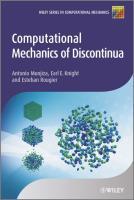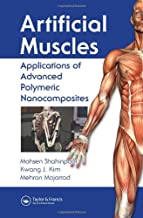Computational Mechanics of Discontinua
Original price was: ₹12,043.20.₹9,634.56Current price is: ₹9,634.56.
ISBN: 9780470970805
Author/Editor: Antonio A. Munjiza
Publisher: John Wiley
Year: 2012
1 in stock (can be backordered)
Description
Mechanics of Discontinua is the first book to comprehensively tackle both the theory ofthis rapidly developing topic and the applications that span a broad field of scientific and engineering disciplines, from traditional engineering to physics of particulates, nano-technology and micro-flows. Authored by a leading researcher who has been at the cutting edge of discontinua simulation developments over the last 15 years, the book is organized into four parts: introductory knowledge, solvers, methods and applications. In the first chapter a short revision of Continuum Mechanics together with tensorial calculus is introduced. Also, a short introduction to the finite element method is given. The second part of the book introduces key aspects of the subject. These include a diverse field of applications, together with fundamental theoretical and algorithmic aspects common to all methods of Mechanics of Discontinua. The third part of the book proceeds with the most important computational and simulation methods including Discrete Element Methods, the Combined Finite-Discrete Element Method, Molecular Dynamics Methods, Fracture and Fragmentation solvers and Fluid Coupling. After these the reader is introduced to applications stretching from traditional engineering and industry (such as mining, oil industry, powders) to nanotechnology, medical and science.
Additional information
| Weight | 0.59 kg |
|---|
Product Properties
| Year of Publication | 2012 |
|---|---|
| Table of Contents | Series Preface xi Preface xiii Acknowledgements xv 1 Introduction to Mechanics of Discontinua 1 1.1 The Concept of Discontinua 1 1.2 The Paradigm Shift 3 1.3 Some Problems of Mechanics of Discontinua 7 1.3.1 Packing 7 1.3.2 Fracture and Fragmentation 8 1.3.3 Demolition and Structures in Distress, Progressive Collapse 11 1.3.4 Nanotechnology 12 1.3.5 Block Caving 15 1.3.6 Mineral Processing 16 1.3.7 Discrete Populations in General 16 References 18 Further Reading 18 2 Methods of Mechanics of Discontinua 21 2.1 Introduction 21 2.2 Discrete Element Methods 21 2.2.1 Spherical Particles 22 2.2.2 Blocky Particles 23 2.2.3 Oblique and Super-Quadric Particles 23 2.2.4 Rigid Potential Field Particles 25 2.2.5 3D Real Shape Particles 25 2.2.6 Computer Games and Special Effects 26 2.3 The Combined Finite-Discrete Element Method 27 2.4 Molecular Dynamics 28 2.4.1 Common Potentials 29 2.5 Smooth Particle Hydrodynamics 31 2.6 Discrete Populations Approach 33 2.7 Algorithms and Solutions 35 References 36 Further Reading 37 3 Disc to Edge Contact Interaction in 2D 39 3.1 Problem Description 39 3.2 Integration of Normal Contact Force 39 3.3 Tangential Force 44 3.4 Equivalent Nodal Forces 45 Further Reading 46 4 Triangle to Edge Contact Interaction in 2D 47 4.1 Problem Description 47 4.2 Integration of Normal Contact Force 47 4.3 Tangential Force 54 4.4 Equivalent Nodal Forces 55 Further Reading 56 5 Ball to Surface Contact Interaction in 3D 59 5.1 Problem Description 59 5.2 Integration of Normal Contact Force 59 5.3 Tangential Force 73 5.4 Equivalent Nodal Forces 74 Further Reading 75 6 Tetrahedron to Points Contact Interaction in 3D 77 6.1 Problem Description 77 6.2 Integration of Normal Contact Force 79 6.3 Tangential Force 84 6.4 Equivalent Nodal Forces 86 Further Reading 86 7 Tetrahedron to Triangle Contact Interaction in 3D 89 7.1 Problem Description 89 7.2 Integration of Normal Contact Force 89 7.3 Tangential Force 99 7.4 Equivalent Nodal Forces 101 Further Reading 102 8 Rock Joints 103 8.1 Introduction 103 8.2 Interaction between Mesh Entities in 2D 104 8.2.1 Interaction between a 2D Disk and a Straight Edge 105 8.2.2 Numerical Integration of the Roller-Edge Interaction 111 8.3 Joint Dilation 113 8.4 Shear Resistance of a 2D Rock Joint 116 8.5 Numerical Examples 120 References 124 Further Reading 124 9 MR Contact Detection Algorithm for Bodies of Similar Size 125 9.1 The Challenge 125 9.2 Constraints of MR Contact Detection Algorithm 125 9.3 Space Decomposition 127 9.4 Mapping of Spherical Bounding Boxes onto Cells 127 9.5 Spatial Sorting 129 9.6 Quick Sort Algorithm 130 9.7 MR-Linear Sort Algorithm 135 9.8 Implementation of the MR-Linear Sort Algorithm 136 9.9 Quick Search Algorithm 141 9.10 MR-Linear Search Algorithm 143 9.11 CPU and RAM Performance 145 9.12 CPU Performance and RAM Consumption 151 References 152 Further Reading 152 10 MR Contact Detection Algorithm for Bodies of Different Sizes 155 10.1 Introduction 155 10.2 Description of the Multi-Step-MR Algorithm (MMR) 155 10.3 Polydispersity 156 10.4 CPU Performance 157 10.5 RAM Requirements 158 10.6 Robustness 158 10.7 Applications 160 Further Reading 160 11 MR Contact Detection Algorithm for Complex Shapes in 2D 163 11.1 Introduction 163 11.2 Contactor Circle to Target Point MR Contact Detection Algorithm 163 11.2.1 Cell Size and Space Boundaries 163 11.2.2 Rendering of 2D Target Points onto Cells 166 11.2.3 Sorting of Target Cells 167 11.2.4 Interrogation Tools for Sorted Target Cells 167 11.2.5 Rendering of 2D Contactor Circles onto Cells 168 11.3 Contactor Circle to Target Edge MR Contact Detection Algorithm 176 11.3.1 Rendering 2D Target Edges onto Cells 176 11.3.2 Searching for Contacts 182 11.4 Contactor Triangle to Target Edge MR Contact Detection Algorithm 184 11.4.1 Rendering 2D Triangles onto Cells 185 11.5 Extension to Other Shapes 192 11.6 Reporting of Contacting Couples 193 Further Reading 194 12 MR Contact Detection Algorithm for Complex Shapes in 3D 197 12.1 Introduction 197 12.2 Rendering Target Simplex Shapes 198 12.2.1 Rendering 3D Points onto Cells 198 12.2.2 Rendering 3D Edges onto Cells 198 12.3 Sorting Target Cells 210 12.4 Target Cells Interrogation Tools 211 12.5 Searching for Contacts 212 12.5.1 Rendering Contactor Tetrahedron 212 12.5.2 Rendering Contactor Triangular Facet 226 12.5.3 Rendering Other Contactor Simplex Shapes 241 Further Reading 241 13 Parallelization 243 13.1 Introduction 243 13.2 Domain Decomposition Approach 247 13.2.1 Communication Engine 252 13.2.2 Broadcasting Engine 254 13.2.3 Summing Engine 254 13.2.4 Gathering Engine 256 13.2.5 Distribution of Physical Objects across Processors 257 13.2.6 Creating Proxies 258 13.2.7 Relocating Originals 259 13.3 Graphics Processing Units (GPU) 260 13.4 Structured Parallelization 262 Further Reading 263 Index 265 |
| Author | Antonio A. Munjiza |
| ISBN/ISSN | 9780470970805 |
| Binding | Hardback |
| Edition | 1 |
| Publisher | John Wiley |
You must be logged in to post a review.






Reviews
There are no reviews yet.